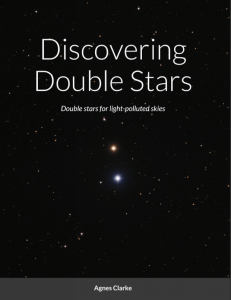Discovering Double Stars is a new book designed to help users find and learn about 179 of the best double stars visible to Northern Hemisphere observers. The book was written by Agnes Clarke, an amateur astronomer in the Netherlands, and is designed to be of use for those living in the glare of urban sprawls, where all but the brightest stars are lost to light pollution.
 Discovering Double Stars offers overview charts that are tailored to light polluted skies that show the general position of the doubles, while generously proportioned detail charts show the precise star patterns around the doubles themselves, enabling an observer to locate the stars through a finder scope.
Discovering Double Stars offers overview charts that are tailored to light polluted skies that show the general position of the doubles, while generously proportioned detail charts show the precise star patterns around the doubles themselves, enabling an observer to locate the stars through a finder scope.
Discovering Double Stars is available as a free PDF download. It is also available as a spiral-bound print copy or with paperback binding.
As Clarke notes, “I wrote this book to help myself find the brighter and better double stars visible from my urban location in the Netherlands, and the charts and contents of the book have been designed accordingly. I observe with smaller telescopes, the largest being a 150mm Schmidt Cassegrain, and the smallest being my 50mm finderscope. Being a northern observer, the doubles in this book do not include those in the southern hemisphere, and come only from equatorial and northern regions of the sky.”
He continued, “I locate targets using a 50mm finderscope and a red dot finder (RDF). The RDF helps me to point the telescope within a few degrees of the target by simply moving the projected red dot in the sight to the right place in the sky, and then the finderscope takes over as it shows about 5-7 degrees of sky with about 8-10 times magnification (it varies because my finderscope accepts different eyepieces).”
This book has two types of diagrams. Large diagrams show brighter stars visible from an urban location with the positions of the doubles indicated as 5 degree finderscope circles. This diagram helps with the rough pointing of the telescope via the red dot finder. Stars down to magnitude 5 are included in these overview charts, which is somewhat fainter than the author can normally see from his back garden, unless if it a good clear night and it is past midnight.
As he notes, “If there is any haze in the sky, it reflects glare from the city and the surrounding greenhouses and then I can only see about half the stars in the overview charts.”
The second type of diagram shows the faint stars visible in his finderscope, so that the double can be located by matching the pattern to the book. The author normally has the finderscope and telescope very precisely aligned, so that he can keep a high magnification eyepiece in the telescope and not have to keep switching between lower and higher magnification in the telescope to center the double in the telescope view. To increase the chance that the double will actually be in the telescope view, he suggests using wide-angle eyepieces so that there still is a reasonably large field of view despite using hundredfold magnification.
Clark also notes, “All 179 doubles in this book have been selected for brightness, color, and uniqueness, and all are within a few degrees of a bright star of at least magnitude 3.5. I have also included the position angles of the doubles in the finderscope diagrams. The position angle indicates the angle from the primary star to the secondary star, and I show this angle as a short line radiating from the double star. In the case the double is actually a triple or quadruple or quintuple the other position angles are shown as progressively shorter radiating lines, in order of increasing separation of the components. So the two components with the closest separation have the longest line.”
All the charts show the rough spectral class of the stars as a color: hot blues stars of spectral class O or B are shown as dark blue. White stars like Sirius or Procyon (spectral class A or F) are shown as black. Yellow stars similar to our G-class Sun are shown as dark yellow, while cooler K class stars are dark orange and M class stars are deep red.
As Clark says, “Note that the separation and position angle of double stars can change from year to year. This is one of the many charms of double stars: they offer the chance to see dynamic processes in deep space. However it does mean the data in this book is only valid as of 2021.
You can learn more about Discovering Double Stars here.
 Finally, And to make it easier for you to get the most extensive news, articles and reviews that are only available in the magazine pages of Astronomy Technology Today, we are offering a 1 year subscription for only $6! Or, for an even better deal, we are offering 2 years for only $9. Click here to get these deals which only will be available for a very limited time. You can also check out a free sample issue here.
Finally, And to make it easier for you to get the most extensive news, articles and reviews that are only available in the magazine pages of Astronomy Technology Today, we are offering a 1 year subscription for only $6! Or, for an even better deal, we are offering 2 years for only $9. Click here to get these deals which only will be available for a very limited time. You can also check out a free sample issue here.



